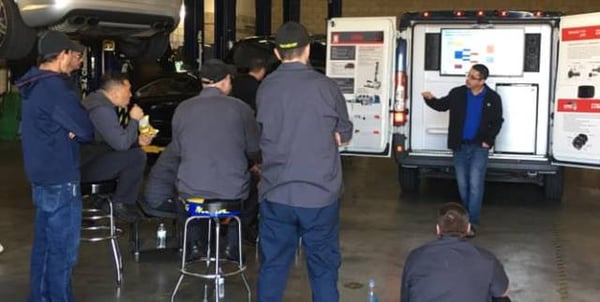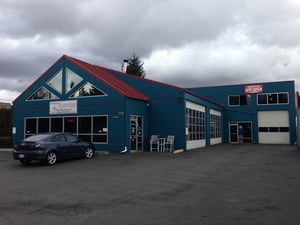The Digital Shop® Blog
7 Simple Steps to a Successful Repair Shop Meeting
If you aren’t meeting with your automotive shop crew regularly, you aren’t doing it right.
Frank Scandura, the owner of Frank’s European Service in Las Vegas has been running weekly or bi-weekly meetings with his employees for years and has seen tremendous results.

“We had a customer come in during our meeting,” Frank told co-hosts of The Digital Shop Talk Radio Tom Dorsey and Uwe Kleinschmidt in an episode earlier this year. “Good, nice, great guy, long-time customer.”
He sat in on this meeting while Frank’s crew discussed integrity and their mission statement, and Frank turned to the motorist and asked him if they deliver.
“He literally got real emotional,” Frank said. “He said, ‘Frank, my life’s a train wreck except when it comes to my car.’ That was really important for the team to hear. Because it is not just me bloviating all the time, this is real. We have an effect on people, and it’s real, and that’s why we’re doing what we’re doing.”
This was just one way Frank has used meetings to unify and galvanize his shop.
Shop meetings make a difference
During The Digital Shop Conference earlier this year, Frank hosted a break-out session sharing some of the knowledge he has gathered during his years of running frequent shop meetings.
(Tip 1) - The seven steps to an awesome shop meeting
First things first, Frank stressed the importance of having a plan when it comes to your meetings. “It’s not a matter of just showing up and saying, 'What do you want to talk about?', right? Because that’s not the way, it’s going to work.”
Instead, he has come up with seven steps he follows during each of his meetings:
-
- Success story – Start with the good news, what has happened recently?
- Shop business – What is going on that week? Does anyone have vacation time? Any equipment updates?
- Previous week performance – How did the shop do last week compared to the goals set?
- Shop goals – What are the goals of the shop? Make sure they are clear, and everyone knows what they are.
- Obstacles in reaching those goals – Are you down an auto technician, so the goals are going to be harder to achieve? Do you have a piece of equipment that is out of order? These things need to be taken into consideration.
- Continuous improvement – Take suggestions from your crew. What ideas do they have to make the shop more efficient or a better place to work?
- Continuous improvement reviews – Time for the follow-up to previous suggestions. Without this, there is a disconnect, and people can forget. How have things changed? What still needs work?
(Tip 2) - A place where even quiet members speak up
Building a community and a culture in the shop which encourages everyone to talk is another critical reason to have these meetings.
“For you shop owners who have tried to have regular meetings, and it’s awkward, and it’s uncomfortable, and nobody had anything to say. Tough. You’ve got to do it,” Frank said. “You have to show consistency, and you have to break out of your own comfort zone and make this happen.”
“You have to find a way to give them the safety and the quiet, to come forward,” he said. “To know it’s okay to say something.”
It never ceases to amaze him, once he gets those quieter team members talking, they often start with the same phrases, “I don’t want to get anybody in trouble,” or “I don’t want anybody mad at me.”
For Frank, there is a natural response. “I say, ‘Okay, they can be mad, or I can be mad, pick,’” he says.
(Tip 3) - How to run the meeting
Another essential part of making these meetings successful is how the shop owner runs them.
“If somebody says, ‘Hey, why don’t we do X, Y, Z,’ and you go, ‘Well, that’s the dumbest thing I’ve ever heard,’” you aren’t going to be successful,” Frank said. You are going to create a culture where no one wants to share ideas, and instead of being proactive, your crew will always be waiting for direction from the top.
However, Frank acknowledges sometimes, with all of the responsibilities which come with running a shop, it is hard to receive suggestions. When that happens, he has a specific way he reacts.
“I say, ‘Okay, yeah, let me give that some thought,’” he said.
This allows him to dig into the idea and think about it. Maybe the whole thing isn’t right, but you could give value to a part of it.
By giving yourself space, you could find pieces that may work.
“I can actually say, ‘Okay, I heard what you said, what are some ways that we can do something close to that,’” Frank said. “And then it really gives value to your people around you.”
Turning Frank’s ideas to action

Sitting in on Frank’s session at the conference was Dave Earp, owner of Village Transmission & Auto Clinic, in Edmonds, Wash. Up until listening to Frank, he was only having meetings when it was desperately needed.
These meetings would address important topics such as policy or workflow changes, or if something needed to be fixed. He learned from Frank, handling the shop this way was problematic for several reasons.
- Meeting instead of beating – The way Dave was approaching meetings at his digital shop was what Frank calls “beatings,” not meetings. What he means is, there is only a meeting when something is going wrong, and when the owner is upset. Those aren’t meetings.
- It can’t be one and done – Dave realized you couldn’t have one meeting and implement something new and expect it to happen. You need to stay on top of it and make sure the changes are made.
- Proactive management vs. reactive management – He also found that by not having consistent meetings, he was unable to alleviate a lot of other stressors that were present at the automotive shop because they were never brought up or shared with him.
- Building a culture – Regular meetings also allow for the crew to build a foundation and culture at the shop. Sharing ideas, creating buy-in, working to improve issues, all of these things create a more positive work environment. This can’t happen if without meetings or only if beatings take place.
Now, Dave is looking at meetings in a new light.
“Well, the first thing I want to say is, why does a football team huddle up?” Dave asked. “Because they need to know the play.”
The same should be true for the members of his crew. With more frequent meetings, he can gather the service advisors at one time to run through the things they need to know, and then have the auto techs huddle and check in with them.
Progress through data collection
Initially, Frank started having recurrent meetings with his crew because he wanted to make some improvements, but he soon realized he couldn’t fix what he couldn’t measure.
That’s where data collection comes in. 
As AutoVitals digital shops, both Frank and Dave have access to the Business Control Panel (BCP), which helps them monitor different metrics that are crucial to the success of a modern shop, including digital vehicle inspections (DVI) completed, DVI sent, and ARO.
Now Frank can look at his BCP to see if his auto repair technicians and service advisors are continuing to meet the goals they’ve set.
“In order to achieve those goals, we need to become more efficient,” he said. “That’s the roadmap that I’m going to lay down for my crew. This is the goal that we want to hit this year, or this month, or this week. And this is how we’re going to get there.”
He is hoping by doing the math for them and showing them what just one more hour each day looks like, over the year, they will be motivated to make some changes.
Since culture isn’t something that can be measured, Frank and Dave are using these other metrics to give their teams something to monitor while they continue their meetings and build a robust digital shop.
Frank echoed Dave’s plans for the year ahead.
Last year he did $2.7 million, and his goal is to become a $5 million a year company ultimately. But he can’t get to $5 million this year. Instead, he has to gradually increase to $2.8 million, then $2.9 million, $3 million, and so on.
“You’ve got to break it down to here’s what it looks like for the year, the month, the week, and the day, and then break it down even further,” Frank said. “How many cars does each service advisor need to bring in each day based on our averages to make it happen? And it becomes reality.”
This can be an uphill climb, though, especially with your techs.
“Not to take anything away from technicians, you guys are incredible,” Frank said. “I started my life as a technician, but y’all can’t see past your next paycheck.”
For auto repair techs who are flagging 50-60 hours week after week, a 30-hour week makes them nervous, and so it is especially important to help them break it down. Focus on efficiency, productivity, making sure to spread out the work, and keeping things even between them.
“Definitely don’t forget to include what’s in it for them,” Dave said.
Watch the full recording of the episode here
Want to hear more from Frank?
- Learn how to market to your current clients in Episode 33 of The Digital Shop Talk Radio
- Learn from Frank and others what makes up a good service advisor in Episode 30 of The Digital Shop Talk Radio
- Curious about the people behind The Digital Shop? Frank joined a panel of others to discuss during Episode 22 of The Digital Shop Talk Radio
- Overcome staff objections and earning buy-in was the topic of conversation for Episode 18
- Frank joins a panel of experts to discuss changing motorist behaviors and the future of automotive repair in Episode 11
- Episode 6 has five do’s and don’ts when it comes to training your staff
How to contact Frank and Frank’s European Service:
Want to hear more from Dave?
- Dave joined a panel of experts in Episode 67 to discuss the impact SA’s have on revenue growth
- Learn how to “Open new doors with a full-time estimator,” in Episode 34
How to contact Dave and Village Transmission & Auto Clinic:
Read On
The Processes You Need to go Fully Paperless
Customers stepping up to the service counter at Downtown Automotive, in Nelson, British Columbia,...Driving Growth With Consistency in the Auto Repair Shop
“The name of this episode is what, consistent processes? We were just talking earlier, saying the...Customers Buy Trust, Not Parts: Why Your SA Matters
Personality, empathy, patience; these are a few of the most important qualities for a service...Posts by Topic
- Digital Shop (47)
- auto repair shop (44)
- automotive shop management software (31)
- Auto Shop (29)
- Autovitals (29)
- DVI (29)
- shop management (25)
- workflow (18)
- Digital Marketing (17)
- BCP (16)
- CRM (15)
- auto repair shop marketing (15)
- Staff Buy-In (14)
- Best Practice (13)
- aro (13)
- Consistency (11)
- Digital Vehicle Inspection (11)
- Process Change (11)
- Tech (11)
- service advisor (11)
- COVID-19 (10)
- KPIs (10)
- Shop Culture (10)
- Websites (10)
- AutoVitals News (8)
- Integration (8)
- Website (8)
- automotive shop software (8)
- Announcement (7)
- Automotive Technician (7)
- Press Release (7)
- Partners (6)
- auto repair marketing company (6)
- auto repair shop SEO (6)
- New Features (5)
- auto repair services (5)
- best auto repair software (5)
- Coaching (4)
- Customer Reviews (4)
- Paperless (4)
- Reviews (4)
- auto shop management (4)
- multishop (4)
- smartflow (4)
- Automotive Technician Shortage (3)
- DRIVE Shops (3)
- Digital Shop Conference (3)
- Industry Events (3)
- Meineke (3)
- NAPA (3)
- Shop-Ware (3)
- auto parts inventory (3)
- auto shop efficiency (3)
- automotive repair invoice app (3)
- creative (3)
- drop off (3)
- training (3)
- web based auto repair software (3)
- Automotive text messaging (2)
- Bookkeeping for auto repair shops (2)
- POS (2)
- Picture Edits (2)
- Protractor (2)
- Recruiting (2)
- RepairPal (2)
- TeE-Times (2)
- The Digital Shop Talk Radio (2)
- inventory management (2)
- loyalty (2)
- Auto mechanic interview questions (1)
- BayIQ (1)
- Building a Bench (1)
- Campaign Manager (1)
- Canned Jobs (1)
- Case Study (1)
- Community (1)
- GMB (1)
- Guided Inspection (1)
- Hiring (1)
- Interview (1)
- MRT (1)
- Motorist Approval (1)
- Q&A (1)
- Remote Work (1)
- Service Writer (1)
- TVP (1)
- Tekmetric (1)
- The Digital Shop Summit (1)
- Who's in our shop? (1)
- auto parts (1)
- auto repair shop financing (1)
- best auto repair shop websites (1)
- estimate (1)
- financing (1)
- inflation (1)
- marketing plan (1)
- parts catalog (1)
- pricing (1)
- retention (1)
- script (1)
- social media (1)
- social media marketing (1)



